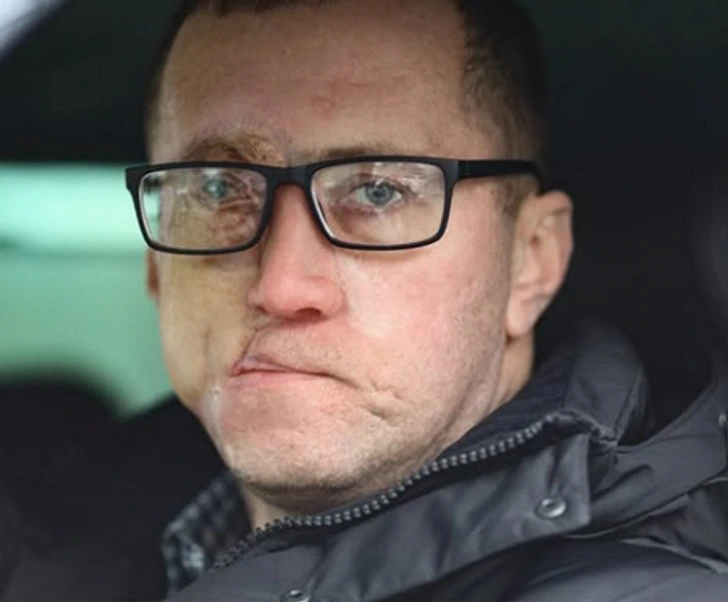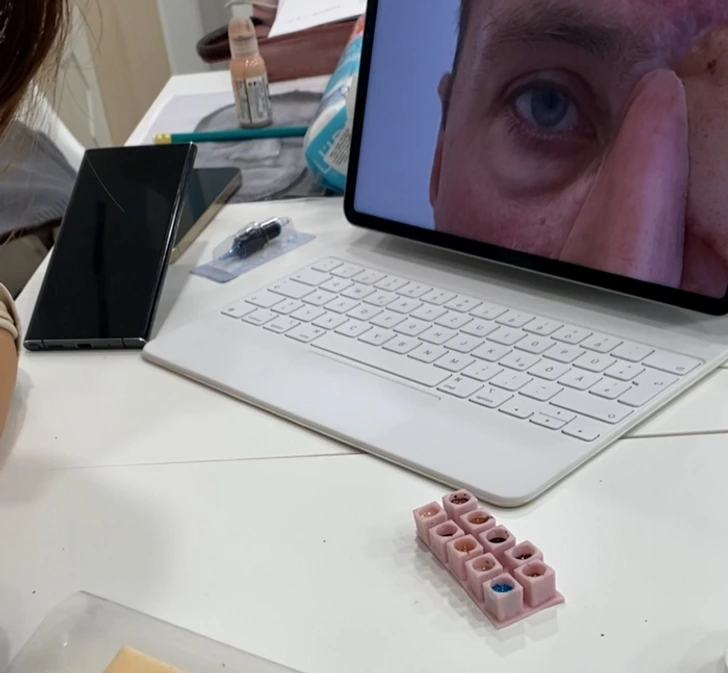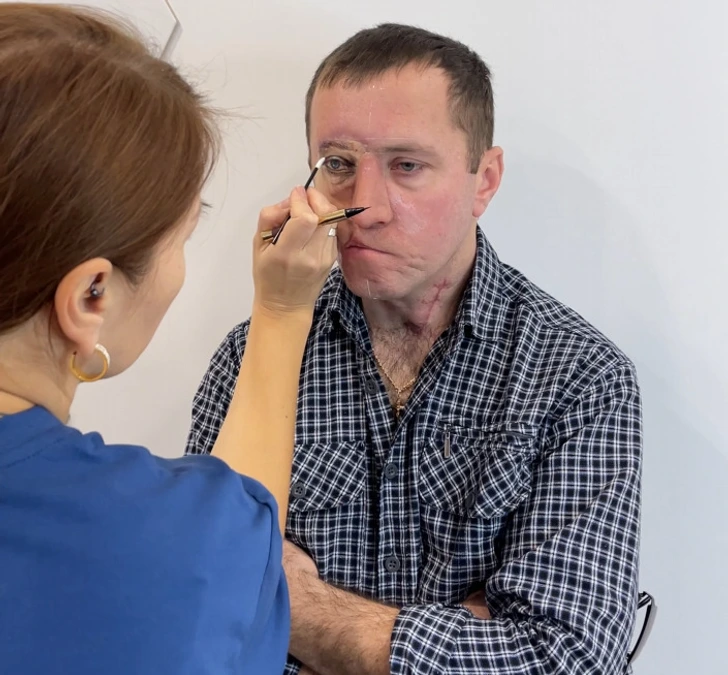For most people, tattoos are a form of self-expression. But for one man, ink became a life-changing solution after a devastating accident left him without an eye. Instead of opting for a traditional glass prosthetic, he took a different path—one that led him to a skilled tattoo artist with the ability to create hyperrealistic tattoos.
A Tragic Accident That Changed Everything

Pavel, a young man with a bright future, suffered a horrific car accident that left him with severe facial injuries. His nose was nearly destroyed, and his right eye was beyond repair. Reconstructing his face would require a series of complex medical procedures, but one of the biggest challenges was how to deal with his missing eye.
Doctors initially explored the possibility of saving what was left of his damaged eye. However, the risk of infection spreading to his healthy eye was too high. The safest option was to remove it entirely.
Pavel accepted the decision with courage, saying:
“I don’t hold on to things that don’t work. It’s better to get rid of something potentially dangerous than to risk losing my other eye too.”
But once the procedure was done, he was left with an important question—how should he replace his missing eye?
From Surgery to Art: A Unique Solution Emerges
Traditionally, people in Pavel’s situation turn to glass prosthetic eyes. But he wanted something different—something that wouldn’t require daily removal or ongoing adjustments.
That’s when doctors introduced him to a highly skilled tattoo artist specializing in hyperrealistic medical tattoos. She had already made a name for herself by helping burn victims, breast cancer survivors, and alopecia patients reclaim their confidence through tattoo artistry.
However, this project was different. She wasn’t just restoring eyebrows or camouflaging scars—she was about to create the illusion of a realistic eye on a flat surface.
This would become one of the most challenging tattoos of her career.
The Artist’s Preparation: A Year of Meticulous Planning
A hyperrealistic tattoo isn’t something that happens overnight. The artist dedicated a full year to studying and preparing for this groundbreaking piece.
Her process included:
- Analyzing old photos of Pavel to match his original eye color and shape.
- Developing a custom pigment palette that could replicate the natural shading of an eye, ensuring the sclera (the white part) didn’t look unnaturally bright.
- Practicing on artificial skin to simulate the texture of scar tissue and skin grafts, testing how ink would blend.
- Consulting with doctors to ensure that tattooing wouldn’t interfere with his healing process.
- Sketching and refining designs over and over again to get the illusion of depth just right.
While the artist prepared, Pavel adjusted to his new face. He remained patient, even joking:
“While you’re practicing, I’ll get used to my new nose!”
Despite the curiosity of strangers, his friends and family stood by him, treating him no differently. Their support gave him the strength to embrace the journey ahead.

The Big Day: Creating a Realistic Eye with Ink
After months of preparation, the day finally arrived. Pavel stepped into the tattoo studio, knowing this was a permanent transformation.
The artist carefully mapped out the placement of the eye tattoo, ensuring that it:
- Aligned naturally with his facial structure.
- Considered the shadows and highlights needed to create depth.
- Worked with the texture of his skin grafts and scars, ensuring the ink settled correctly.
The first outlines were drawn, and within a few hours, the shape of an eye began to emerge. When the artist handed Pavel a mirror, he smiled and said:
“Wow! It actually looks like something!”
There was still work to be done—adding highlights, refining details, and perfecting the illusion—but the transformation had begun.
The Power of Medical Tattoos: A Growing Trend
Pavel’s story isn’t just a remarkable example of tattoo artistry—it’s part of a growing movement where tattoos serve medical and emotional purposes.
Some of the most impactful medical tattoo techniques include:

- Scar camouflage tattoos, which help burn victims and surgery patients feel more comfortable in their skin.
- 3D nipple tattoos, which help breast cancer survivors reclaim their bodies after mastectomies.
- Eyebrow tattoos, providing a solution for alopecia patients and chemotherapy survivors.
- Skin pigmentation correction, helping people with vitiligo and birthmarks achieve a more even skin tone.
The use of hyperrealistic tattoos in medical recovery is revolutionizing self-confidence, showing that tattoos are not just about self-expression—they’re about self-restoration.
More Than Ink: How Tattoos Can Heal Beyond the Surface
Pavel’s journey highlights an important truth—tattoos have the power to change lives.
Beyond their visual appeal, medical tattoos help individuals regain control over their bodies after trauma. Studies show that people who undergo these procedures experience:
- Increased self-esteem
- A renewed sense of identity
- Emotional healing after a traumatic experience
For many, these tattoos shift the focus from loss to empowerment, allowing them to move forward with confidence.

Conclusion: A Story of Strength, Art, and Transformation
Pavel’s story is a testament to resilience, innovation, and the transformative power of art.
With the help of a brilliant tattoo artist, he didn’t just replace his missing eye—he reclaimed his confidence.
His journey serves as a powerful reminder that true beauty isn’t about perfection—it’s about embracing what makes you unique and finding strength in the face of adversity.
In the world of medical tattoos, artists aren’t just creating inked designs—they’re restoring hope, identity, and dignity.
Weekend Puzzle Fun: Can You Find the Hidden Objects in This Balcony Gardening Scene?
If you love brain teasers and challenging puzzles, you’re in for a treat! This balcony gardening scene is more than just a beautiful illustration—it contains hidden objects cleverly concealed within the image. Your task? Find them all!
At first glance, everything might seem perfectly normal, but if you look closely, you’ll notice that some objects are not where they should be. Can you spot all the hidden items in this vibrant and lively balcony garden? Take a deep breath, sharpen your focus, and let’s begin!
Why Spotting Hidden Objects Is Harder Than You Think

Before we dive into the solution, let’s talk about why finding hidden objects is so challenging.
Many people make common mistakes when attempting to solve these types of puzzles. Here’s why:
- Our brains focus on the bigger picture – We tend to look at the entire scene instead of noticing small, misplaced details.
- Background distractions – With so many colors and patterns in a single image, it’s easy for hidden objects to blend in.
- Misleading elements – Some objects are cleverly camouflaged with similar shapes or colors to trick your eyes.
- Rushing through the puzzle – If you scan too quickly, you might overlook tiny details that make all the difference.
So, what’s the best approach? Slow down, examine each area carefully, and let your mind adjust to finding irregularities.
Video : Find It – Hidden Object Games
Step-by-Step Guide to Finding the Hidden Objects
Let’s analyze this balcony gardening scene and reveal all the hidden objects one by one. Follow along to see if you’ve found them all!
1. The Horseshoe Near the Balcony Edge
A horseshoe is cleverly placed near the railing. Since it matches the metal bars, it blends in seamlessly. Tip: Always check objects that look slightly off from their surroundings!
2. The Banana Hidden Among Flower Pots
Look closely at the flower pots—you’ll notice something yellow peeking out. That’s a banana tucked between the pots! Tip: Unusual shapes among plants are often a good hint for hidden objects.
3. A Bow Hanging on a Tree
Among the lush greenery, a small bow is attached to a tree branch. It blends in because of the similar color tones. Tip: Hidden objects are sometimes placed in natural settings where they don’t belong.
4. A Toothbrush Leaning Against the Balcony Railing
A toothbrush is barely noticeable because it matches the background. It’s leaning on the railing, almost camouflaged. Tip: Look for small, vertical objects that could be hiding in plain sight.
5. A Pencil in the Corner Next to a Plant
This one is tricky! A pencil is partially hidden in the plant leaves. It looks like a natural part of the plant at first glance. Tip: Pay attention to thin, straight objects that could resemble plant stems or branches.
6. A Magnifying Glass on a Leaf
A magnifying glass is resting on top of a large leaf. It’s transparent, which makes it harder to see. Tip: Check for objects with circular reflections or glass-like appearances.
7. A Flag Sticking Out Behind a Flower Pot
A small flag is partially visible, peeking from behind a pot. Since it’s in the background, it’s easy to miss! Tip: Always check the edges of the image for hidden surprises.
8. A Paintbrush Lying Next to the Watering Can
A paintbrush is discreetly placed beside a watering can. Its wooden handle blends with the surroundings, making it tough to spot. Tip: Look at areas where gardening tools and artistic tools might mix together.
9. A Diamond Ring Buried in the Soil
Hidden in the pile of soil, a diamond ring sparkles faintly. It’s hard to see because it’s partially covered by dirt. Tip: Shiny objects are often placed in dull environments to hide them better.
10. A Cupcake Sitting on the Window Ledge
A small cupcake is positioned on the windowsill, blending in with the potted plants. The colors make it look like part of the flowers, making it tricky to identify. Tip: Always check window areas for unexpected objects.
11. A Ruler on the Balcony Floor
A ruler is discreetly lying on the floor among the gardening tools. Since it’s long and thin, it blends into the scene perfectly. Tip: Watch for straight-line objects that mimic flooring patterns.
12. A Spoon Inside a Flower Pot
A spoon is strangely placed inside a flower pot. At first glance, it looks like part of the soil. Tip: If something shiny catches your eye, take a second look!
13. A Small Bell Attached to the Balcony Railing
A tiny bell is fastened to the side of the railing. It’s positioned so it almost disappears into the metal bars. Tip: Look for circular objects that blend into structures.
14. A Worm Hiding in the Soil
A tiny worm is camouflaged in the brown soil. Its curved shape mimics small plant roots, making it difficult to detect. Tip: Pay attention to small details in textured areas like dirt or leaves.

How Many Did You Find?
This puzzle tests your ability to observe details carefully. Some objects were obvious, while others were expertly hidden within the scene. If you found them all, congratulations—you have an eagle eye for detail!
If you missed a few, don’t worry. Hidden object puzzles are great for sharpening your brain and improving your ability to notice small changes.
Video : Can You Find the Hidden Objects in These 09 Pictures ?
Challenge Your Friends!
Think you did a great job? Share this puzzle with your friends and see if they can find all the hidden objects too!
Drop a comment below with how many objects you found before looking at the answers!
Tag a friend and challenge them to beat your score.
Try more spot-the-object puzzles to train your brain and have fun!
Are you ready for the next challenge? Stay tuned for more puzzles that will test your skills!



Leave a Reply